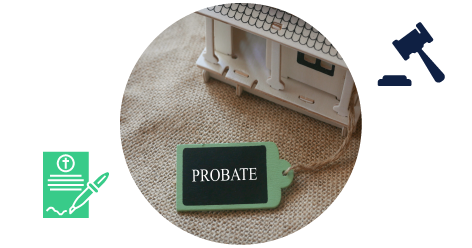The Pro Guide to Home and Property Owner Prospect Lists That Convert

Buying prospect lists is easy.
In fact, it's so easy that most businesses are buying the same lists as everyone else... and then marketing to the same lists as everyone else, with the same message as everyone else.
While straightforward, there are two big problems with the generic list buying strategy:
- You're likely to waste time and money marketing to everyone with the same generic message, and
- You're competing with everyone else in your industry by doing the same thing.
What's the solution? Stop buying generic lists and instead create highly targeted audiences of people with a list builder.
So, instead of buying the same lead lists as everyone else and likely getting the same results, use a powerful real estate list builder to find people more likely to become your next customers.
However, before we get into list building, it's important to note that building and buying lead and prospect lists are not exclusive.
The best strategies often leverage both, but it's essential to use bought lists within the list-building process to benefit most from the combined data sources, criteria, and filters.
We know a thing or two about list builders...
At PropertyRadar, we offer the industry's best list builder. With 250+ criteria and nationwide data covering 150+ million properties, we've helped property-centric businesses build highly targeted, up-to-date lists for years. We want to help you do the same.
So, whether you're currently using PropertyRadar or not, we're here to show you why buying and using the same lists as everyone else isn't going to cut it and how building hyperlocal prospect lists will ensure you're building high-quality lead lists that are far more likely to convert.
In this complete guide, we'll run through everything you need to know to start creating highly targeted lead lists that you can use to find more customers, connect with them more effectively, and of course, close more deals:
- Big Picture: Buying Lists vs. Building Lists
- The Complete Guide to Real Estate Prospect List Building
- Choose the right list builder for you
Big Picture: Buying Lists vs. Building Lists
Whether you're a real estate agent, investor, mortgage broker, or home and property service company, prospect lists are the foundation for building a solid hyperlocal marketing strategy.
For instance, investors looking for distressed owners and properties, real estate agents trying to find likely sellers, mortgage brokers looking for refinancing, reverse, hard money, and LOC opportunities, and home and property services looking for buyers can all use prospect lists to find exactly who they're looking for.
The question is: how do they all generate those lists?
By using a list builder.
What's a list builder?
A list builder is a tool that offers specific criteria and filters to generate a hyper-targeted list of potential leads to which you can then market your offer or services using hyper-personal sales messaging.
In the Marketing industry, a list builder is also called an "audience builder," but we are using "list builder" here as it is more common in the Real Estate industry
For instance, if you want to target homes in pre-foreclosure or with absentee owners over a 2,000sqft, you can use a list builder to set the criteria and return a list of homes that fit those criteria.
In general, you can build two kinds of lists and potentially leverage hundreds of available data points to create a list. Depending on your business, you may utilize some or all of the available criteria to build exhaustive market lists and highly targeted segmented lists.
We'll go into more detail on the two kinds of lists below.
Why is a list builder necessary?
Buying a list is easy, but building a list provides far more value. Of the many benefits, there are three essential things to consider:
- A list builder allows you to build audiences to your exact specifications.
- A list builder enables you to build out segmented groups.
- A list builder allows you to test unique messaging on your segmented audiences/groups.
To clarify why a list builder is so important, let's first evaluate buying a list…
Consider buying a list of home and property owners that fit your target market. They may represent your total addressable market, but marketing to all of them in the same way and with the same messaging is far from ideal.
Sure, buying a list is easy, but building a list provides far more flexibility for you to segment your audience into groups that share similarities.
These similarities, whether based on property characteristics, demographics, or transaction data, will enable you to focus on specific groups of people that you can then pitch to in ways that are more likely to resonate with them.
Buying pre-made and brokered lists limit your ability to differentiate
There's a right time for buying lists— and most of the time, that's when they allow you to supplement or augment your list builder.
However, it's important to remember that when you're purchasing a list, they're often pre-made and undifferentiated.
Pre-made lists are widely available from list sellers and title companies. Unfortunately, they're often more expensive than a list builder. Brokered lists may be customized to your criteria but are expensive and often outdated.
At the end of the day, when the same list is resold over and over, there's a significant decrease in its effectiveness. In addition, the list(s) won't be unique to your requirements and often, they're only created monthly, so they may be outdated.
If you buy a list, it could be outdated at any time
Just bought a list? The more unique and special it is, the greater its potential value—however, depending on how frequently the data is collected and reported, the sooner it could also be outdated, incomplete, and inaccurate.
For example, a list of new homeowners in your area likely changes daily.
For instance, USPS may consider Rural addresses' vacant' after 90 days have passed while city addresses are considered 'vacant' at the USPS's discretion.
Using a dynamic monitored list will ensure that your list is as up-to-date as the data source itself.
The Complete Guide to Real Estate Prospect List Building
Step 1: Know which kind of list you need
There are two different types of lists: static and dynamic.
Let's take a look at each of them, and some of the benefits they provide.
Static lead lists represent a single moment in time
When you buy a list, you can specify a specific set of criteria and build a list of leads matching precisely the qualifications you're looking for.
Given this list represents a moment in time, they're considered "static".
Many investors, agents, and property-centric businesses start out using bought, static lead lists to help build the foundation of their marketing strategy.
When should you use a static lead list?
When you need total control over your list
The more you use a static lead list over time, the more familiar you'll become with it and, therefore, understand exactly who you're targeting.
Since there are no changes or leads added, unless you do so manually, you can rest assured that your list remains the same.
For instance, if you use a list showing houses on the waterfront, you can import that list and know it's highly unlikely to change significantly (if at all) over the course of the year.
Knowing your list like the back of your hand comes in handy, especially if you're inventorying your leads. You know exactly who lives where and there are no surprises.
When you need reliability
Your static lists will always represent a moment in time, so if you need to go back and reference your list, it will always represent the same data.
For example, if you believe there was a particular lead in your neighborhood when your list was created, but it appears as if they've now moved out of town, your static list will validate or disprove your theory.
Now, let's go ahead and take a look at the other type of list, the Dynamic Lead List…
Dynamic lists are ongoing, living databases
A list of leads you purchase is a one-time downloadable file that quickly becomes outdated — if it doesn't already contain expired data — a dynamic lead list is in an ongoing, live database that is continually updated and verified for accuracy.
A dynamic list builder can track real-time changes to the lead's qualification based on your criteria and automatically update the lead list database to ensure that you're working with accurate, timely information.
This is why creating a dynamic list is one of the more popular lead generation strategies.
As you look to build on your reputation as a market leader, dynamic lists are an invaluable asset to use as part of your marketing strategy.
Furthermore, when you build out a dynamic list, you can see when new leads who match the criteria are included in the list, allowing you to quickly reach out with proven messaging you've verified through repeated testing.
When should you use a dynamic list?
When you need automation
With a dynamic list, you can be confident that the data you're referencing is likely still accurate and reliable.
Typically, dynamic lists automatically update, meaning you won't have to take the time to manually verify every lead in your database to ensure you have the most up-to-date information.
When you need adaptability
One of the best things about dynamic lists is that they give you the most current data on demand, allowing you to have the most relevant data for your business.
For instance, if you find that you want to shift the focus of your investment strategy, you don't have to go through the hassle of spending time trying to buy the perfect list. Instead, you can make it yourself - keeping you adaptable and able to pivot at a moment's notice.
When you need real-time accuracy
Another benefit of dynamic lists is that property + owner information is typically accurate and up-to-date.
This means that when a new property is updated and fits your list's criteria, your dynamic list will add it in real-time (as opposed to a bought list, which is a snapshot into a moment in time).
Here's an example…
Let's say you have a dynamic list of Absentee Owners in your neighborhood.
One day, a new owner moves into a home on your Absentee List moves and marks it as their primary residence.
That property will no longer fall into the category of "absentee owner," so a monitored list will remove the lead from your list.
In the opposite case, where an owner vacates the property and becomes an absentee owner, your dynamic list will add both the property and the owner to your dynamic lead list.
This means that you'll be able to stand out against another real estate agent or investor who's reaching out to buyer and seller leads with outdated data.
Step 2: Use list criteria
Now that we've run through different list types, let's cover the criteria you need to build powerful prospect lists.
Your filters and search criteria should be detailed and hyperlocal based on your real estate business's specific investment targets.
When real estate industry leaders use a list builder (like PropertyRadar) they use criteria to:
Specify geographic location
Consider your service or offer.
Should it change based on neighborhood, city, or county lines?
Targeting homeowners in a historic neighborhood may be different than targeting homeowners in a new development.
For example, as a roofer, you may want to pitch a different kind of roof depending on the landscape of the geography.
Specify property details
Similar to geography and location, property details may be just as important for creating a list of prospects.
Think about what's essential to your real estate investing and lead capture strategy...
If you're a home survive business, perhaps you're trying to find homes based on lot size or home square footage. If you're an investor, maybe you're looking for vacant properties, homes in pre-foreclosure, or homes with HOA liens.
At the end of the day, every investor or property-centric business owner is different, and you'll need to pursue property details aligned with your strategy.
Whatever the criteria you need for property details to align with your strategy, you can use a wide range of filters in your list maker to generate the most relevant lists possible for your business.
Specify owner information
Consider demographics such as age, marital status, income, and other attributes.
If you run a house cleaning business and are looking to target homeowners who may need some assistance, you may want to create a list of homeowners over a certain age with a home above 2,500 square feet.
However, always follow our Good Neighbor Pledge to market and generate leads ethically based on demographic information.
Step 3: Apply list filters
By using a list builder with a robust set of criteria you can then leverage the available criteria and data points to narrow down your audience.
This is a process of filtering. However, rather than thinking of this as filtering down, it's also appropriate to think of this as audience building—building the targeted audience most likely to need your services or respond to your offer.
When using criteria filters, it's important to consider a few things: audience targeting, message matching, and new opportunity discovery.
Use criteria for better audience targeting
The primary goal of using criteria is to target an audience that's not only likely to need your services but who is also most likely to respond to your offer. An easy example to consider is the new homeowner on a large lot without a pool. In time they may be a great potential customer, but for the time being, it's not likely they have equity or can refinance to pay for it.
Filtering by new homeowners on large lots without pools really isn't sufficient. Doing so is likely to waste money and effort.
Instead, apply purchase dates, estimated equity, and even demographic data that could help suggest if a pool is more or less likely to resonate with the homeowner.
Use criteria for better message matching
The second use of criteria isn't about reducing your audience, but rather segmenting it.
In other words, just because you use specific criteria doesn't mean your total addressable market is reduced, it just means that each segment within it should receive unique sales messages that are more likely to resonate with them.
Think about it this way - for a roofing company, messaging should be much different for older homes that need a roof replacement than it is for newer homes that need recurring maintenance.
Use criteria to discover new opportunities
The third use of criteria filters can be applied to discovering new, and previously unknown, opportunities. Exploring filters you're unfamiliar with can often lead you to new insights that uncover new customer opportunities.
Consider trying criteria filters you haven't yet used, or thinking about a new sales message you haven't tried and then finding the audience that it may resonate with most.
Step 4: Market to your list
Once you've built a list of new leads using a dynamic list-builder tool, engaging the opportunity through multichannel marketing is next.
7 marketing strategies to engage your pipeline
Strategy #1: Email
Emailing is the most common lead generation tactic, but one that, if done correctly, can yield incredible results at a low cost.
Potential buyers and sellers will want to see that you've done your research, so layering as much personalization from your dynamic list criteria will make your marketing budget go further.
Strategy #2: Direct Mail
While digital marketing and other virtual forms of marketing have their place, sending physical mail to prospective customers via direct mail is still one of the most effective tactics you can employ.
Strategy #3: Phone Marketing
We're all familiar with cold calling, but you can substantially improve your cold calling process with power dialer tools to help make more calls every hour.
We recommend using scripts based on which dynamic list you're calling that day. That way, you're delivering personalization to each lead you speak to, making your marketing efforts and each conversation you have much more impactful.
Strategy #4: Door Knocking
For things like distressed properties, you can even Drive For Dollars and door knock once you've identified a dynamic list that makes sense to go after.
It's a great way to test different messaging, especially since you can see how leads react in real-time and get immediate feedback.
Additionally, leads produced from this method already have familiarity with you, helping you build relationships more quickly.
Strategy #5: Online Advertising (Google, Facebook, YouTube, Instagram, LinkedIn)
Real estate websites will likely deploy some online advertising to drive leads to their site.
As mentioned before, if you leverage a list builder with a dynamic list of leads that fit your criteria, your return on online advertising will likely be much higher.
Testing messaging that resonates and using different tactics to speak to audiences one-to-one will almost always outperform generic online ads.
Strategy #6: Direct Social Media Messaging
Messaging potential leads on social media is a newer way real estate professionals can choose to engage with buyer leads or seller leads.
Furthermore, you can even engage past clients to leave positive reviews for your real estate business on social media sites.
Strategy #7: Fully Integrated Hyperlocal Marketing Campaign
Hyperlocal marketing is community-centric and value-driven targeted marketing that can be used by small and medium-sized businesses to find and connect with new customers, clients, and opportunities more effectively than big businesses.
Your list serves as the foundation for effectively marketing to specific areas, neighborhoods, or geographies with common characteristics and values.
By creating a cohesive strategy that targets a specific location with value-driven messaging, you'll be able to scale your hyperlocal marketing campaign and convert more prospects in your area
Recap - Use a List Builder to Close More Deals
A successful list builder software can identify high-potential local investment opportunities — and streamline the process of engaging your leads through effective direct marketing strategies.
When shopping for a list builder for your real estate marketing efforts, make sure that it offers the features you need to find, connect with, and close deals.
Consider the following questions:
- Does it offer the list types you need?
- Does it offer the criteria to find customers?
- Does it offer the filters to properly segment?
- Does it offer monitoring to keep it up to date?
Consider the following criteria:
- Data quality & timeliness
- Number and variety of criteria
- Demographics data
- Filtering by Phone & Email
- Ongoing updates
- Insights
- Automations & Alerts
- Customizable exports
- Integrations
- Built-in list stacking
- Price
Get total control over your lead generation efforts
When you build a dynamic list of real estate leads based on a specific set of unique, individualized criteria, you automatically set yourself apart from competing investors who rely on generic lists from outside providers.
By basing your lead generation strategy on the foundation of a dynamic list, you can fully control the types of leads and lead data you want to see.
If you rely solely on the exclusive leads and data you're getting by working with other lead generation companies, you will have to work within their limitations.
Verify Lead Quality
By building a dynamic list, you'll also be able to verify all of the information contained within your list to ensure that the data is current, accurate, and reflects the real-time circumstances of the property.
You can almost guarantee that your competitors are (at least partly) relying on outdated, or "dirty," data for lead capture - and this will give you a leg up when you reach out to buyer and seller leads.
While no data set is ever 100% perfect, you can quickly check up on the status of each property and update your list with new data.
Stand Out From Your Competition
When you're purchasing a list of seller leads, for example, it's essential to remember that you're rarely going to be the only person in the local real estate market with that same data.
However, when you build your dynamic list to generate leads, you can specify specific criteria on top of what you already have, giving your lead generation the edge it needs to outperform cookie-cutter outreach by your competitors.
The seller leads on that list have likely been approached already by investors, meaning that you lose the edge of being the first to take action on a potential deal.
Moreover, you would probably be fighting for the same seller leads as your competitors, bought lists may not always contain accurate, complete, and up-to-date data.
You often don't know where that information was sourced or when your list was pulled. For example, it could have been pulled last week from a reputable source or last year from a less reputable or consistent source.
If you're purchasing a list, it's impossible to know the answers to crucial questions that determine the viability and quality of your lead list.
How PropertyRadar's List Builder builds better lists that convert
PropertyRadar's dynamic list-builder tool achieves all of the targeted list builder features, helping investors identify and access unique opportunities within a targeted area.
With the ability to build multiple lists with varying criteria, you can leverage up-to-date data at scale to empower your marketing to help you hit your company's revenue goals.




